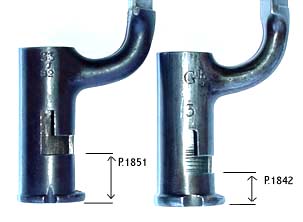.
P.1851 Minie Rifle

| OA | 534mm | Bl | 437mm | Sl | 78.5mm | Mrd | 22mm | Sm | 31.5mm | Bw | 29.5mm |
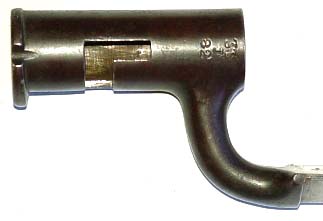
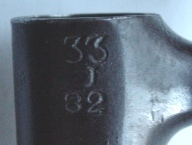
Socket marked '33' over 'J' over '82', this is the 33rd Regiment of foot, Company 'J', Weapon '82'.
The 33rd The Duke of Wellingtons Regiment (West Riding) (1782-1853 - 1st Yorkshire West Riding). Battle honors during the Crimean War, ALMA, INKERMAN and SEVASTOPOL.
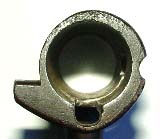
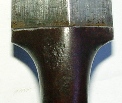
Lovell catch and sight notch. New Land Pattern Shoulders.
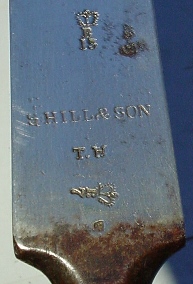

The blade is marked 'S.Hill & Son', this is Stephen Hill [1], a Birmingham maker noted between 1830-1849 as 'S.Hill', and as 'S.Hill & Sons' between 1849-1855.
(1) British & Commonwealth bayonets by Ian D Skennerton and Robert Richardson, page 397, ISBN 0 949749 04 4
This picture illustrates the key point in identifying a newly made P.1851 from a
P.1842, the first step of the mortise of a P51 is approximately 9mm longer than that
of a P42. The SM is also fractionally different between the P51 and P42. However some P1842
bayonets were heat shrunk and their third step increased so that they could fit on P51
muskets. Approximately 18000 P42 bayonets were converted. It is
also believed that a number of 1842 muskets were converted to the Minie
system by rifling the old barrels, the existing P1842 bayonets would
then have been used unmodified except for additional inspection marks
applied to the face of the bayonet at the same time as the
conversion. Every P51 or modified P42 seen by myself have had the
same inspection mark across the face of the blade. The mark is a
'Crown' above 'B' above a '7'. This is clearly the mark of an
inspector working in the period 1851-54 as it has been found on Carbine
Muskets and bayonets. Very few P1851 were made as soon after the
initial issue then they were replaced by the P1853 Enfield.
